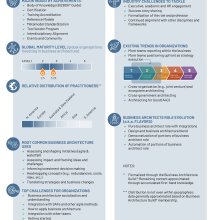As we’re nearing the end of another trip around the sun, it’s a good time to reflect on our global business architecture community, the discipline and to look forward and dream. Here’s some food for thought as you do your own reflections, both individually as well as perhaps with your internal business architecture team and even your local community. Here goes.
Note: Unless otherwise noted, the content contained here is based on continued, extensive global engagement with and visibility to business architecture practitioners, organizations applying business architecture, and various industry groups.
What is the composition of the global business architecture community?
First, let’s start with who the we is in this global business architecture community. We are an ever-increasing group of global practitioners located on six continents, and currently concentrated in the areas of North America, Europe, Australia and New Zealand, with growth in Africa and Asia.1 (BTW, the distribution is not even across or within these areas.) The number of practitioners and organizations that are beginning to practice business architecture is continually increasing across different geographies and industries. Yippee!
Regardless of what corner of the planet we inhabit, we are special people with much in common. We embody passion and possibility for things to work differently, better, in our organizations and societies, with a new vision for how we execute strategy, collaborate and create value. P.S. We’ll put a little bit of science around what makes business architects so special in an upcoming StraightTalk post slated for early next year. Can’t wait.
What’s the global state of business architecture?
We have some major business architecture industry achievements to celebrate. For example, we have:
- A shared business architecture body of knowledge (the BIZBOK® Guide).
- A first-level certification and training accreditation based on that body of knowledge.
- Industry reference models (capability maps, value streams and other content).
- Metamodel standardization (a.k.a. the set of defined aspects that encompass business architecture and their relationships to each other).
- A growing market of aligned tool vendors.
- Ongoing alignment with other disciplines, frameworks and associations (e.g. experience design, business process, requirements, SAFe, TOGAF, etc.).
- An increasing number of organized events and community globally.2
While we still have much to do, all of these things have significantly contributed to the formalization of the discipline which increases the credibility and market around business architecture.
As organizations, how are we doing?
One key indicator is business architecture maturity, based on the industry standard Business Architecture Maturity ModelTM (BAMMTM), which measures how mature an organization’s business architecture practice is. The more mature an organization’s business architecture practice is, the more strategic and embedded it becomes – and the more value it delivers. (More on business architecture maturity in Post No. 20, Charting The Course and Post No. 44, The Business Architecture Summit.)
Globally, we see a significant majority of organizations that are investing in business architecture that fall between a mid-level 2 and a low to mid-level 3 in maturity (on a scale that ranges from 1 to 5). Yes, there are organizations that have achieved maturity levels 4 and 5 and are leading the way, but many more are on the journey now and will be the leaders of tomorrow.

P.S. If you have not done so already, it’s a great time to perform an annual business architecture maturity assessment with your team and create your practice advancement roadmap for next year.
Another key indicator of how we’re doing with business architecture is of course results. The set of case studies and success stories shared at events and among communities is increasing, but we need to get better at writing them down and sharing them. Make a new year’s resolution to share at least one story next year. (More on business architecture metrics in Post No. 21, By The Numbers and more on calculating Return on Business Architecture Investment (ROBAI) in Post No. 57.)
Where are business architecture teams succeeding?
Business architecture teams are getting better at building standardized capability maps, information maps and value streams – and they are doing so quicker than ever due to the availability of industry reference models. They are also getting better at maturing their internal business architecture practices with intention and finding new and creative ways to educate others and build advocacy.
In addition, some of the most common uses of business architecture right now (but by no means anywhere near an inclusive list) include:
- Assessing and shaping initiatives (regardless of the delivery method).
- Assessing impact and framing ideas and challenges.
- Informing investment decision-making.
- Heatmapping concepts for new insights (e.g. redundancies, costs, risks, etc.).
- Translating strategies and other business changes into coordinated, actionable initiatives.
Where are business architecture teams challenged?
Globally, the top challenge for business architecture teams is still socializing business architecture and creating an understanding of and buy-in for the discipline within their organizations. (So, you’re not crazy and you’re not alone.) However, the awareness has increased as a result of your efforts and the industry formalization mentioned earlier. We have a loooong way to go, but it’s getting a little easier. And there is momentum, attention, and in some cases targeted efforts to try to educate and influence executives, the academic community, human resources and the general business community. (Get the straight talk on socialization in Post No. 2, Start With Why, Post No. 3, The Strategy Execution Metanoia, Post No. 34, Business Marketecture and Post No. 37, Business Politecture.)
Beyond socialization and buy-in, business architecture teams globally share some other common challenges, such as:
- Integrating business architecture with SAFe and other agile approaches. (Check out Post No. 27, Being on the SAFe Side.)
- Determining how to actually use business architecture and apply it to deliver value. (Check out Post No. 56, A Win-Win Situation for ideas on quick wins and Post No. 55, Decision, Decisions on leveraging business architecture for decision-making.)
- Integrating business architecture with other teams and into the strategy execution life cycle. (Check out Post No. 5, We Are Family on integrating with other teams and Post No. 50, Living The Dream on integrating into the strategy execution life cycle.)
- Getting started. (Check out Post No. 4, Let’s Get This Party Started for guidance on how to establish a business architecture team.)
- Working in ways that engage others. (Check out Post No. 64, The Business Architecture Imperative to show up with wow.)
What does the future hold for the business architecture discipline?
From a business architecture industry perspective, there are some key challenges to tackle in order to continue advancing and expanding the discipline. To name a few, this includes:
- Educating and engaging the executive, academic and human resources communities.
- Disseminating success stories, case studies and hard numbers.
- Formalizing the role and profession.
- Continually aligning with other disciplines, frameworks and industry associations.
How are organizations evolving the practice and role of business architecture?
While the intention and scope of business architecture and its integration points with other disciplines and roles has only become clearer over time, how organizations manifest the practice of business architecture currently has some different flavors and others are emerging. These approaches, and others, will likely continue to play out in different ways and the reality is that as long as we honor and standardize around the principles of business architecture, organizations and individuals can truly do what works best for their situations. There does not need to be a one-size-fits-all approach because organizations, geographies and cultures need different things. Hybrid approaches are also likely to occur.
Here are a few flavors of how business architecture is being practiced or is envisioned to be practiced:
- The practice of business architecture is focused through the pure business architect role that integrates with other disciplines (including integration with the other IT architect roles within enterprise architecture).
- Practitioners practice a blended role of experience design / human-centered design and business architecture.
- Practitioners blend enterprise or solution architecture aspects with the business architect role. (Note: Teams tend to be moving away from this flavor as it often proves to be less successful for a variety of reasons, but nonetheless it does exist and works for some.)
- All or a portion of the business architect role is democratized through the usage of business architecture by many people in different roles and for different scenarios across the organization.
- Aspects of the creation and usage of business architecture are automated.
P.S. You can find more on the Evolution of the Business Architect Role here.
What’s on the horizon for business architecture teams?
Some exciting trends are evident and emerging! Here are just a few highlights:
- More business architecture teams report within the business – this is the continuation of a trend we’ve seen for a while now. (More on team structure in Post No. 7, An All-Star Cast and Post No. 8, Organizing For Success.)
- More business architecture teams are positioning themselves strategically, as the bridge between strategy and execution (upstream of initiative planning) with a focus on strategic business usage of business architecture. This includes leveraging business architecture for business and digital transformation. More and more new teams are positioning correctly from the beginning while those that have been on the journey for a while continue to shift left.
- Cross-organization architecting is envisioned and beginning. For example, business architecture has been leveraged across two organizations for joint ventures, mergers and acquisitions. Business architecture has also been leveraged across multiple organizations and to design ecosystems that deliver new value. (More in Post No. 53, Ecosystem is the New Organization.)
- Cross-government architecting is envisioned and beginning. This includes creating and leveraging a shared business architecture (and at least some portions of IT architecture such as software services) across government agencies within a country – or across multiple countries.
- Business architects are using their talents for good. (More at Architecting For Good and also see Posts No. 17 and 18, Architect The World Part 1 and Part 2.)
Here’s a fab graphic to summarize all of that for you.
And here’s a big thank you to all business architecture leaders, practitioners and advocates of the discipline. We raise a glass to you for the tireless passion and effort that you expend every day to socialize and practice the business architecture discipline in ways that make our organizations and world a better place. Continue to dream big and do good.
More Good Stuff…
Crystal Ball as of 2018: Business Architecture Now + A Glimpse Into the Future (S2E StraightTalk): More on the topic from our 2018 edition. Still applicable.
Enterprise Architecture: Key Business Priorities and Success Factors for 2019 (Whynde Kuehn for Cutter Consortium): Key priorities and practices of successful EA teams. Still applicable.
Business Architecture 2019: Where We Are and Where We Are Headed (Business Architecture Guild®): An update from the last BA Guild Business Architecture Innovation Summit in 2019.
The Global Goals We’ve Made Progress On and the Ones We Haven’t (TED Talk): Speaking of global progress, here’s an interesting TED Talk by Michael Green, an economist who has been part of the team that has created the Social Progress Index. Green shares his analysis on the steps each country has (or hasn’t) made toward the UN Sustainable Development Goals and offers new ideas on what needs to change so we can achieve them.

